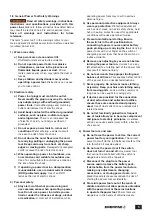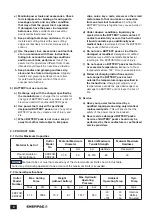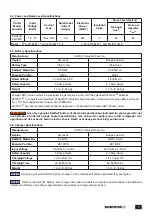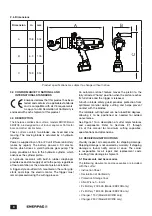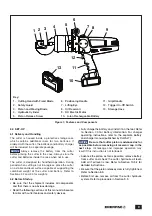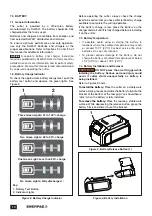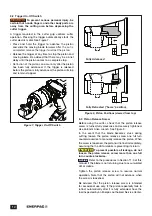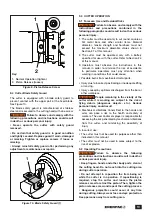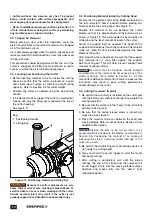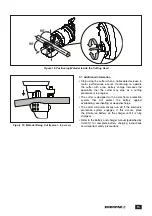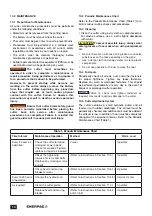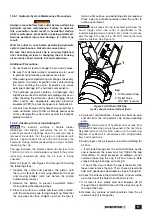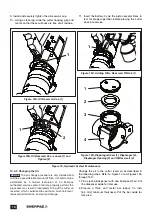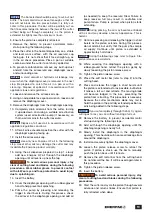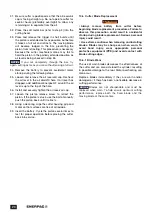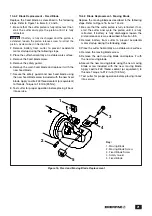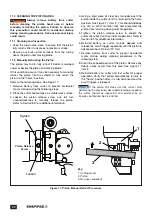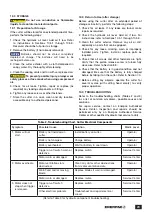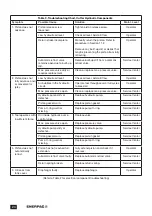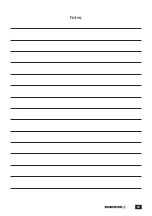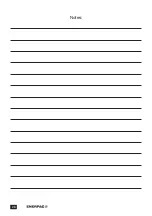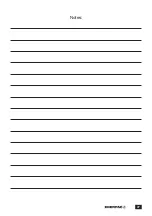
19
(as needed) to keep the reservoir filled. Failure to
keep reservoir full may result in cavitation and
pump failure. Pump is primed when piston starts
extending.
NOTICE
During priming, the oil may become entrained
with air and may develop a foamy appearance. This is
normal.
17. Continue pressing and releasing the trigger in short
bursts as the piston extends. During this process,
do not add oil, but verify that the pump has ample
oil supply. Continue until piston is extended to
approximately half stroke.
NOTICE
During the following steps, refer to Figure 9 for
piston release screw details.
18. While covering the diaphragm opening with a
rubber-gloved hand, retract the piston gently by
slowly loosening the piston release screw.
19. Tighten the piston release screw.
20. Place the soft metal bar (refer to step 2) into the
cutting head.
21. Press and release the trigger in short bursts until
the piston is extended as far as possible, but before
it makes a full cut and retracts. The moving blade
will become lodged in the bar, preventing the
piston from retracting. This procedure is necessary
because the cutter mechanism alone may fail to
hold the piston in the partially extended position as
oil is being added in the following steps.
NOTICE
If you cut completely through the bar, try again,
cutting as far as you can without making a full cut.
22. Remove the battery to prevent accidental motor
startup during the following steps.
23. Add oil through the diaphragm opening until the
diaphragm opening is nearly full.
24. Slowly install the diaphragm in the diaphragm
opening. This should result in some oil leakage from
around the diaphragm.
25. Install and securely tighten the diaphragm cover.
26. Loosen the piston release screw to retract the
piston. If piston is stuck, use the bar to manually
push the piston back until it retracts.
27. Remove the soft metal bar from the cutting head.
Do not discard the bar. It will be used again later in
this procedure.
28. Tighten the piston release screw.
29. Insert the battery.
NOTICE:
WARNING
To avoid serious personal injury, stay
clear of cutting head and blades during the following
procedures.
30. Start the cutter and cycle the piston through several
advance and return strokes. Ensure that piston is
fully retracted when done.
NOTICE
The bar selected should be easy to cut, but not
brittle. The bar material must be soft enough so that the
bar will not break into two pieces before it is fully cut.
Later in this procedure, the bar will be partially cut so
that it becomes lodged in between the jaws of the cutter
without being cut through completely, as the piston is
extended to slightly less than maximum travel.
3. Ensure the piston is completely retracted.
4. Remove the battery to prevent accidental motor
startup during the following steps.
5. Place the cutter in the horizontal position, on a stable
and level work surface, with the oil reservoir cap
facing up. It is not critical that it face straight up, as
in the oil check procedure. Place a pan or suitable
container under the cutter to catch any spilled oil.
6. To prevent contamination, remove any built-up dust
and dirt from the oil reservoir cap, diaphragm cover,
and surrounding area.
NOTICE
A small amount of hydraulic oil leakage may
occur when the diaphragm cover is removed in the next
step. Be prepared to catch this oil in a pan or with a
clean rag. Dispose of spilled oil in accordance with all
applicable laws and regulations.
7. Loosen and remove the oil reservoir cap.
8. Using an adjustable face spanner wrench, loosen and
remove the diaphragm cover.
9. Remove the diaphragm from the diaphragm opening.
10. Completely drain all old oil from the cutter, turning
it upside down and using a suitable oil extraction
system (used oil extraction pump) if necessary, so
that no oil remains in the cutter reservoir.
NOTICE
Dispose of all used oil in accordance with all
applicable regulations and laws.
11. After all oil is evacuated, position the cutter with the
diaphragm opening facing up.
12. Install the oil reservoir cap.
NOTICE
Use only new Enerpac HF oil in the following
step. Use of other oils may damage the cutter and may
invalidate the Enerpac product warranty.
13. Using the oil dispenser prepared in step 1, slowly
add new Enerpac HF oil through the diaphragm
opening until oil level is up near the top.
NOTICE:
WARNING
To avoid serious personal injury, stay
clear of cutting head and blades during the following
procedures. Wear rubber gloves to prevent contact
with oil. Wear eye and face protection to avoid injury
due to splashing oil.
14. Insert the battery.
15. Cover the diaphragm opening with a rubber-gloved
hand to help prevent oil splashing.
16. Prime the pump by pressing and releasing the
trigger in short bursts. During this process, check
the oil level in the diaphragm opening and add oil
Содержание EBC20B
Страница 25: ...25 Notes...
Страница 26: ...26 Notes...
Страница 27: ...27 Notes...
Страница 28: ...199 Gateway Ct Columbus WI 53925 USA www enerpac com Made in Italy WWW ENERPAC COM...

